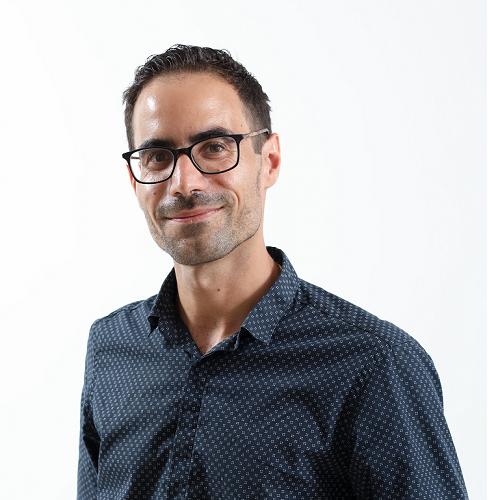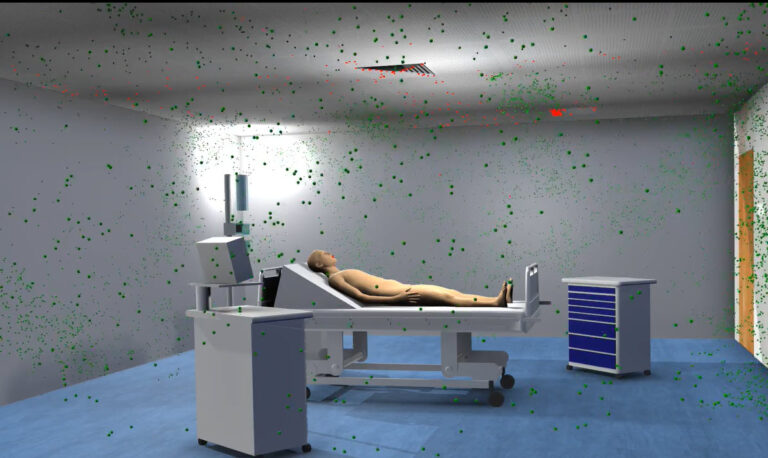Growing up, Emmanuel Vanoli dreamt of working at the prestigious Pasteur Institute in Paris and one day finding a vaccine for AIDS. However, over the course of his time in university, Vanoli ended up finding a new passion in aerospace and a fascination with rockets and aircraft. That passion led him to earn a master’s degree in aerospace engineering and take up a career working on simulations in transportation-related industries like aircraft and automotive, looking at how air flows around the structure of vehicles.
But when COVID-19 set in, companies everywhere started scaling back, some even closing. And with travel coming to a sudden halt, businesses in the world of aerospace were some of the hardest hit. As a result, Vanoli, who was working as an engineer at Dassault Systèmes at the time, saw his own workload start to slow. And with that extra time, he and his family started seeking out ways that they could help make an impact while at home. In what felt like an instant, he traveled back in time, stepping right into that childhood dream of helping make an impact in the world of medicine and healthcare.
The father of two young twins, Vanoli’s children are a huge part of what inspires him to give back, help others and find ways to make the world better. As the pandemic continued to disrupt everyday life, he began volunteering with Institut de l’Engagement, an organization that provides young people with mentors and civic service opportunities in different areas. With the organization, he served as a mentor for young people, guiding them with advice and support to help them find their way as young adults.

Vanoli also began contacting local hospitals in the east of France, near where he was from, to see what they were facing and where the challenges were. At the same time, the situation quickly became even more personal, when Vanoli’s grandmother, who was 88 at the time, found herself hospitalized with COVID-19. And, just like that, Vanoli knew he needed to find a way to help.
After talking to the director of the hospital caring for his grandmother, he learned the facility faced two main challenges.
The first, unsurprisingly, was a shortage of personal protective equipment like masks and face shields. To address this, Vanoli leveraged his own network within Dassault Systèmes to connect the hospital management with the makers of 3D-printed face shields. And within days the hospital received supplies and equipped their staff with the much-needed protection.
It was the second challenge that proved to be much more vexing for the hospital leaders. They were struggling to understand how, and why, so many staff ended up contracting COVID-19.
Responding to this challenge would set Vanoli on a career-altering path toward the creation of PRISMES, a project helping reimagine how we visualize the spread of infectious diseases.
PRISMES and tracking the flow of airborne contaminants in hospitals
Vanoli immediately started thinking about how he could apply his work in airflow simulations to map out how COVID-19 was spreading within the hospital. “We can simulate airflow for an aircraft, so maybe we can simulate what’s going on inside a hospital,” he explained.
And with that realization, Vanoli got to work building a virtual twin based on the blueprints of the hospital. From there, the task shifted toward building a simulation that could accurately account for all of the variables that exist in a hospital from air conditioning vents to doorways and hallways.
That effort resulted in what today has become known as PRISMES. The PRISMES project uses Dassault Systèmes’ SIMULIA simulation software to create a virtual model and analyze the way airflow and droplets spread throughout the rooms and vents of a building.
What the first simulation showed was groundbreaking. By modeling what was happening in the real world, Vanoli’s simulation uncovered an airborne transmission pattern that found a correlation between the proximity of the COVID-19 area in the hospital and the area that was designated for elderly patients. “We found that there was a risk of cross-contamination because most of the airflow in the Covid area had been traveling to the safe area,” said Vanoli.
That insight enabled the hospital to take action. The virtual twin created through PRISMES mapped out the spaces within the hospital, showing where air particles were flowing and how air conditioning, open doors, windows and a host of other factors impacted its movement. With those learnings in hand, the hospital began testing new ways to mitigate the airborne spread of COVID-19 in their facility with precautions, like masking and moving more vulnerable patients to different areas.
From there, word of this project began spreading through hospitals across France. Vanoli and Dassault Systèmes began receiving requests from these facilities to help tackle airflow challenges in their own operations. And so, PRISMES went from an experiment to a promising new project at Dassault Systèmes.
The project’s goal quickly transformed into helping even more hospitals and healthcare facilities get a handle on how airflow was affecting the spread of not just COVID-19, but all kinds of airborne contaminants in their institutions.
“We are trying to figure out how can we impact the world healthcare system?” said Vanoli. “How can we bring this technology to any hospital in the world?”
Bringing PRISMES to the world
After helping that first hospital, the PRISMES project began working with some major hospitals to help uncover the airflow problems that were afflicting their emergency departments and intensive care units.
PRISMES has been a revolutionary project, allowing hospitals to actually see and visualize how air is traveling through their halls. In these simulations, air particles go from invisible to a brightly colored dots bouncing around the walls of a room. The results made it clear to see the impact of airflow in a given space, without needing to be a simulation expert. It offers a totally new perspective on the airborne transmission of contaminants to a hospital in a way they would otherwise never have seen.
Whenever Vanoli and his PRISMES teamwork with a hospital, there’s some education that happens to share ideas and bring engineering concepts into the equation. And when first presenting data to hospital staff, Vanoli was nervous about how they would react.
“I was pretty scared before the first meeting because I was in mindset of, ‘Will they understand any of what I present?’” said Vanoli. But with a simulation like the one he built, the visual element breaks down a lot of barriers and makes the data easy to understand for doctors, nurses and administrative staff alike.
“When you can see the air evolving in real-time in your hospital, even complex things get very simple to understand,” said Vanoli.
And the results speak for themselves. “The reaction from healthcare practitioners, it’s amazing,” said Vanoli. “You can really feel the fact that you are bringing them something completely new and providing an answer they didn’t expect to be able to have.”
It’s been an incredibly rewarding and unique experience for Vanoli so far. It was a project sparked by a love of family and a desire to help healthcare organizations and workers in his local community that ended up becoming a defining feature of his role with Dassault Systèmes. And, as he explained, it changed everything. “I found a real goal I want to pursue and to realize,” said Vanoli.
Tapping into the full potential of virtual twins and simulations
If there’s one thing Vanoli has learned from his time building the PRISMES project, it’s just how impactful virtual twins can be, not only in healthcare but for society at large too – particularly in a post-COVID-19 world.
Vanoli sees a world where these types of simulations can be used in other settings where large groups of people may gather. “During the first wave of COVID-19, we used to work a lot with concert halls,” he said. With the goal being to help those venues understand what’s happening inside their buildings and, eventually, get ready to reopen safely.
Thinking about other challenges that he hopes to conquer in the future, Vanoli believes there is potential for airflow simulations to go beyond mapping the spread of contaminants and disease. He’s also found a thread that leads directly to a more sustainable world, too. Simulations give a virtual look at how something will behave in an environment before it happens. So, someone building a new structure can better account for the variables that come with regulating temperature and reducing energy consumption.
“With a virtual twin of a building, including the ventilation system, the material, the sun, and so on, you can have a good idea of how much you need to heat and how much you need to refresh throughout the year to maintain a given temperature,” said Vanoli.
The PRISMES project has come a long way since Vanoli set out to help hospitals visualize the air flowing through their halls. What started in the very hospital that treated his grandmother has grown into a massive project with the potential to protect the thousands of patients, staff, and visitors that enter hospitals every day.
It’s been an incredibly transformative experience for Vanoli. And as for Vanoli’s grandmother? She’s all recovered from COVID-19. And, thanks in part to his work, future trips to the hospital have become much safer.
As Vanoli looks to the future, there’s still plenty left to do. With such a large, growing project is a marathon, not a sprint. And Vanoli is all in on fully developing the capabilities of PRISMES and making virtual twins and simulations an industry standard for hospitals and healthcare facilities.
Going back to his childhood, Vanoli has always wanted to make an impact in the world of medicine. What started with a dream to create groundbreaking vaccines has now morphed into a role that lets him tap into that passion to help medical facilities improve safety and better care for patients.
Emanuel Vanoli isn’t the only one helping reshape the world of healthcare. Check out some of the other humans driving progress.

